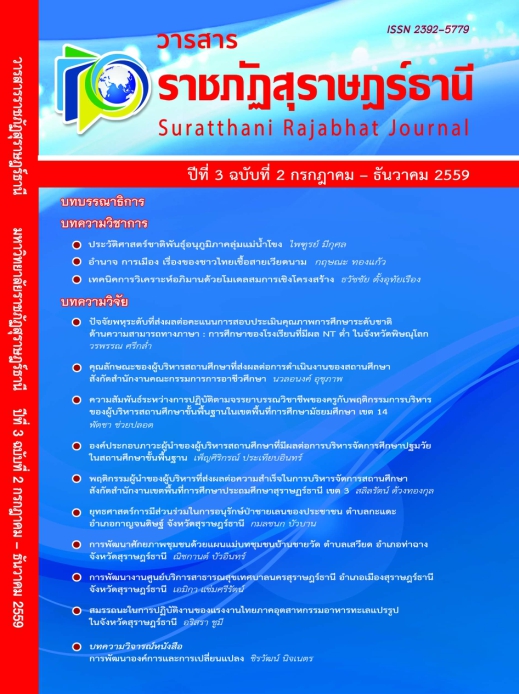Thailand's Workforce Competency on the Seafood Processing Industry Sector in Surat Thani Province
Main Article Content
Abstract
The objectives of the research were to 1) study the factor of human resource management., 2) study the working performance, 3) compare working performance divided by personal factors, 4) study the relationship between factors of human resource management with Thailand’s workforce competency, and 5) provide suggestions to develop Thailand’s workforce competency on seafood processing industry sector in Surat Thani Province. Data was collected from 360 people ranging from managers, leaders, staff and Thai labors who was working in seafood processing industry sector in Surat Thani Province by using questionaires with a reliability of 0.93. Data was analyed using basic statistics including percentage and S.D. Test statistics were T - test, One - Way ANOVA and Pearson Correlation Coefficient.
The research found that the overall factors of human resource was at high level. Each of 6 aspects were at a high level, which were competency evaluation, staff developmet, manpower planning, morale, recruitment and selection of personnel, and payment of compensation. Practice competency for overall was excellent and each of 4 aspects was at high level , which were ethics, efforts, accuracy of work, and achivement. In terms of accumulated expertise in career, it was partly at high level. The comparison resulted on educational level, different incomes which had the capacity to perform different tasks statistically significant at the 0.05 level. The relationship between human resource factors and practical competency was overall positive at moderate level. The development on practical competency was paying compensation in accordance to competency, choosing the right man to the right job, training at least once a year, conducting the activity, giving annual bonus and an award for outstanding employees.
Article Details
References
ณัฏฐพันธ์ เขจรนันทน์. (2551). พฤติกรรมองค์การ. กรุงเทพฯ : ซีเอ็ดยูเคชั่น.
พยอม วงศ์สารศรี. (2545). การบริหารทรัพยากรมนุษย์. กรุงเทพฯ : สำนักพิมพ์สภา.
พัชรินทร์ ทานนท์. (2552). การประเมินสมรรถนะพนักงานบัญชีของการไฟฟ้าส่วนภูมิภาค เขต 2 ภาคเหนือ(พิษณุโลก) ตามเกณฑ์มาตรฐานยุทธศาสตร์การพัฒนาบุคลากรภาครัฐ. ภาคนิพนธ์บัญชีมหาบัณฑิต สาขาวิชาการบัญชี บัณฑิตวิทยาลัย มหาวิทยาลัยเชียงใหม่.
พิสณุ ฟองศรี. (2547). การประเมินทางการศึกษา แนวคิดสู่การปฏิบัติ (พิมพ์ครั้งที่ 2). กรุงเทพฯ : เทียมฝ่า.
วรากรณ์ สามโกเศศ. (2552). เรื่องน่ารูเกี่ยวกับสมรรถนะ. มติชนรายวัน, 6.
สราวรรณ์ เรืองกัลปวงศ์. (2552). ปัจจัยที่ส่งผลต่อคุณภาพชีวิตของพนักงานในสถานประกอบการอุตสาหกรรมเอกชนจังหวัดนนทบุรี. กรุงเทพฯ : สำนักงานคณะกรรมการวิจัยแห่งชาติ (วช.)
สำนักงานคณะกรรมการข้าราชการพลเรือน. (2551). สมรรถนะของราชการพลเรือนไทยกรมการปกครอง. (Online) สืบค้นได้จาก : http//www.dopa.go.th/web_pages/ m030200002competency/ck1.2.ppt. [2559, มกราคม 20].
สำนักงานอุตสาหกรรมจังหวัดสุราษฎร์ธานี. (2556). สถิติโรงงานภายในจังหวัดสุราษฎร์ธานี ประจำปี 2556. สุราษฎร์ธานี : กระทรวงอุตสาหกรรม.
สุณีย์ ล่องประเสริฐ. (2547). ระเบียบวิธีวิจัยทางธุรกิจ. สุราษฎร์ธานี : คณะวิทยาการจัดการ มหาวิทยาลัยราชภัฏสุราษฎร์ธานี.
สุนันทา เลาหนันท์. (2546). การบริหารทรัพยากรมนุษย์ (พิมพ์ครั้งที่ 2). กรุงเทพฯ : คณะวิทยาการจัดการ สถาบันราชภัฏบ้านสมเด็จเจ้าพระยา.
Fottler, M.D., Hernandez, S.R., and Joiner, C.L. (1998). Essentials of Human Resources Management in Health Service Organization. Albany : Delmar Publishers.
Mondy, Wayne R. & Robert M. Noe. (1996). Human Resource Management. Upper Saddle River, NJ : Prentice-Hall.


